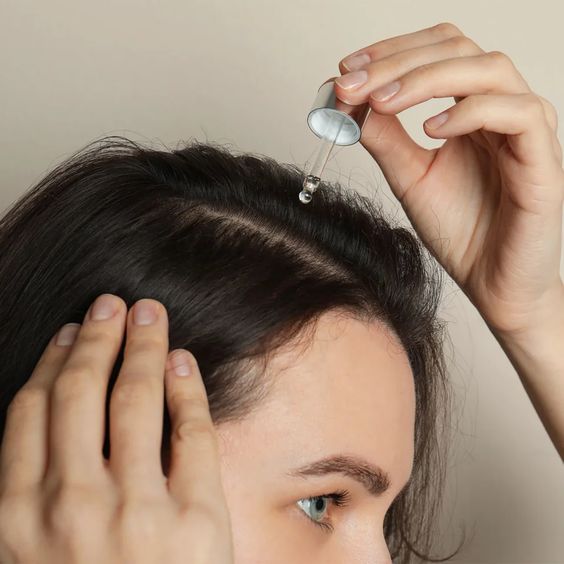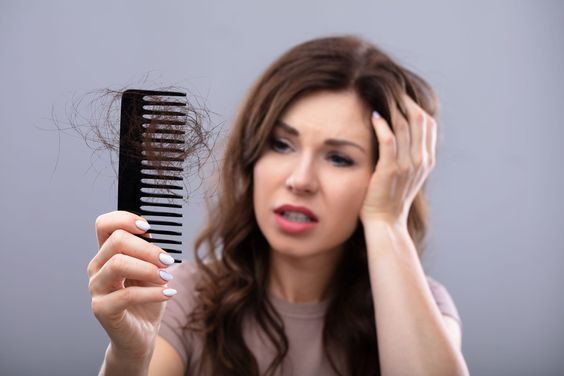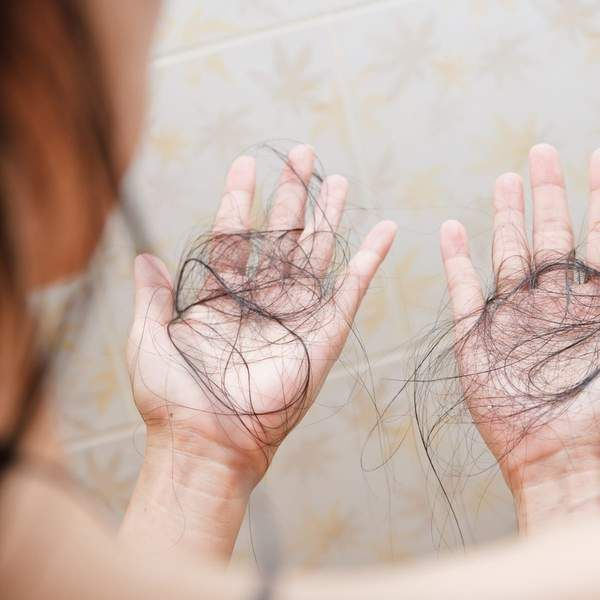Background Intro
Thinning hair and hair loss can be a distressing experience that can affect a person's self-esteem and confidence. But there's no need to worry, as there are proven hair loss treatment strategies to address the problem.
Related: Hair Damage: What Causes It And How To Deal With It
Also the wig will help you regain your courage and confidence during the process. In this comprehensive guide, we will explore the causes of thinning hair . By understanding the factors that contribute to hair loss, you can make informed decisions and regain control of your hair's health.
Related: Hair Loss In Women: What Causes It And How To Solve It?
What Is The Best Wig For Baldness & Thinning Hair?
Main Harvest
-
Choosing the right treatment for the cause of thinning hair is important.
-
Medical treatments can be used to prevent hair thinning, like prescription drugs and advanced surgery.
-
Non-medical interventions and lifestyle changes can also help prevent thinning hair.
What is Thinning Hair and What Causes It

Understanding the causes of hair loss is very important for determining treatment. Hair loss can be attributed to many factors, including genetic hormonal fluctuations, certain medications and medical conditions.Female hair loss and sexual hair loss are two common age-related hair loss conditions .
Diagnosing hair loss requires a physical examination and gathering information about diet, hair care, medical history, and family history. Once the cause of hair loss is identified, we can determine an effective treatment to slow hair loss and develop new hair loss treatments.
Identify Hair Loss Types
Female pattern hair loss (androgenic alopecia) and Female-pattern baldness are the two main types of hair loss. Female hair loss is related to genetic or age-related hormonal changes, so hair regeneration is a challenge.

Recognizing the difference between gradual hair thinning and sudden hair loss is helpful in choosing an effective treatment for the cause.
FPHL and Family History
Very common in women is female pattern hair loss (FPHL). Although in most cases it is a non-scarring, non-inflammatory condition, the decrease in hair density often leads to psychological distress in the patient, mainly manifested in the retention of the forehead hairline, but the gradual loss of hair in the middle of the scalp and the forehead area.
Further research is still in progress .Family history is another important factor leading to hair loss. A family history of female hair loss is at risk of developing this disease ,because the disease is hereditary and can be passed down from generation to generation .Recognizing the role of heredity and family history in hair loss is the key to seeking treatment.
Which Types of Women are More Likely to Suffer from Hair Loss
Hereditary hair loss:The most common genetic condition is androgenetic alopecia. If you have inherited these genes from both or one of your parents, you may face this condition. Women with this condition may notice a widening of the top part of the head starting when the woman is in her 40s or 50s.
Women with inflammatory scalp conditions will be more likely to suffer from hair loss than women with healthy scalps, such as eczema and psoriasis. Hair loss in this case needs to be treated properly and the right medication is needed.
There are also a number of reasons for uncontrolled hair loss, including heavy use of harmful hair care products and hair damaged by some heating tools. Also some nutritional imbalances, poor quality of sleep, and some underlying physical illnesses can lead to hair loss.
Medical Treatments for Women With Hair Loss+

Medical treatment of hair loss can help slow down or even reverse hair thinning These treatments include over-the-counter and prescription drugs and hair transplants. Some treatments are mainly for reducing hair loss, while others are for hair regeneration Surgical interventions, such as hair transplant surgery are another option for treating alopecia.
Surgical intervention, such as hair transplant surgery, is another option for treating hair loss. We will now further discuss prescription medications and advanced procedures.
Prescription Medication
Minoxidil and finasteride are commonly prescribed medications for hair loss Minoxidil comes in three dosage forms: liquid foam and shampoo. Minoxidil is used daily by women. Many people report hair regrowth and increased hair loss after taking minoxidil or a combination of minoxidil.

A common side effect of some medications is unwanted hair growth on the scalp and adjacent skin areas. However, this is not always the case.
Treatment with corticosteroids is worth considering for women with hair loss due to alopecia areata. Corticosteroids have the effect of reducing inflammation by applying them to the scalp or injecting them into multiple areas of the affected area. People with alopecia may also benefit from immunosuppressants such as methotrexate.

Advanced Surgery
Hair transplantation is an advanced procedure in which hair is removed from the donor area and transplanted to the recipient area. This treatment has a lasting effect on some types of hair loss, but potential risks include infection and scarring.
The most common hair transplant procedures are unit transplantation and unit extraction. In the latter, a single strand of hair is transplanted to the area of hair loss, and these advanced procedures could offer hope and a permanent solution to many hair loss patients.
Non-Medical Interventions to Encourage Hair Growth

In addition to medical treatments, non-medical interventions such as low-intensity laser therapy and natural therapies can promote hair growth and increase hair density. These treatments are a suitable option for those seeking less traumatic hair loss treatments.
Below, we discuss the benefits and potential of low-intensity laser therapy and natural therapies in promoting hair growth.
►Low-Intensity Laser Therapy
Low-intensity laser therapy (LLLT) is an FDA-approved treatment for hereditary hair loss that uses low-power lasers or light-emitting diodes (LEDs) to stimulate hair growth. LLLT is primarily used to treat androgenic alopecia, also known as male or female pattern hair loss. It works by increasing blood flow to the hair follicles, promoting nutrient delivery and stimulating cell activity, resulting in thicker, healthier hair growth.
Studies in chemotherapy-induced hair loss and alopecia areata mice have shown that LLLT can stimulate hair growth, with controlled studies showing a statistically significant increase in hair diameter or density following LLLT treatment.
►Natural Remedies and Supplements
Natural remedies and supplements such as saw palmetto and biotin may help regenerate hair and support hair growth, but more research is needed. A 2005 mouse study investigated the potential of green tea polyphenol compounds as a treatment for hair loss. The results suggest that green tea may be a possible natural treatment for hair loss.
Some of the potential benefits of saw palmetto for hair growth includePreventing hair loss
-
Improving the overall quality of your hair
-
Increasing hair density
-
Reducing scalp inflammation
-
Preventing hair loss
-
Stimulating follicle growth
-
Inhibiting the action of DHT, the hormone that cause hair loss in women.
The recommended dosage of saw palmetto for hair loss is 160-320 mg per day.
Make Lifestyle Changes to Prevent Hair Loss from Getting Worse

Lifestyle changes can go a long way toward preventing further hair loss and keeping your hair healthy. Proper nutrition and a gentle hair care routine can greatly improve the condition of your hair and reduce the likelihood of hair loss.
The importance of a balanced diet and adequate water intake, as well as effective hair care practices to prevent hair loss and hair damage.
►Adjust The Rest

Irregular work and rest, smoking, drinking, etc., will affect the health of hair. Especially at night, the parasympathetic nerve function that helps to grow hair is more active, and it is a good time for hair growth. Don't stay up late, adjust the pace of life and get enough sleep.
Ensuring the quality of sleep is also one of the important reasons as to how we should spend the long peaceful nights. Sleeping caps are indispensable, wearing them will not only enhance your sleep quality, but also protect your hair healthier and stronger!

Related: Why you should wear a sleep cap and how to pick the right one? - WigShe
Nutritional Considerations for Hair Health
A balanced diet with a variety of foods and adequate water intake are essential for maintaining healthy hair. Adequate water intake is essential for scalp and hair hydration and healthy hair growth.
Foods rich in zinc, vitamin C, omega fatty acids, protein, B vitamins, vitamin D, and iron such as sunflower seeds, blackberries, pumpkin seeds, lentils, salmon, avocado, red meat, and oysters are very beneficial for hair growth and health.
Dr. Bergfeld found that combining fortified biotin with zinc was effective in maintaining the health of hair, skin and muscle tissue.
Related: Say Goodbye To Thinning Hair: Effective Strategies For Promoting Natural Hair Growth
Choose the Right Wig
Choosing the suitable wig for you is crucial,They are not too expensive compared to other methods, and they are easier to design and renew. Wig is designed for anyone especially for those suffering from partial or complete hair loss,so it will certainly bring the result you want.
Related: Wig Shopping 101: Your Ultimate Guide To Finding The Perfect Fit
Keep a Positive Attitude
It's a good way to keep a positive attitude. If you have a resting period of discharge, the great pressure will cause a large number of hair follicles to enter the resting period. Within a few months, when you brush or wash your hair, the affected hair will suddenly fall out.
Stress can also trigger alopecia areata. In this case, the immune system attacks the hair follicles, causing hair loss.
Related: Welcome To The Hair Loss Community—A Warm And Inviting Family
Gentle Hair Care Program

Using gentle hair care procedures, such as avoiding harsh chemical treatments, can help prevent hair loss and hair damage. Avoid using sulfates, formaldehyde, keratin, dimethicone, chemical fragrances, sodium chloride, mineral oil, petroleum jelly, PVP/VA copolymers and sodium dodecyl sulfate in hair care products to minimize hair loss. Over-styling and frequent bleaching can weaken hair strands and cause them to break.
To minimize damage to your hair, consider the following tips:
-
Getting regular hair trims
-
Using gentle hair care products
-
Avoiding hot molding
-
Air drying your hair whenever possible
-
Using protective hairstyles,like using a wig or a topper
-
Soft smooth hair
-
Hair care and nourishment
-
Reducing heat on hair
-
Massaging the scalp with hair oil to promote blood circulation and supplement nutrients.
-
Related: Eco-Chic: Transform Your Haircare Routine With Sustainable Choices
When to See a Specialist

The key to getting the most effective hair loss treatment is knowing when to see a specialist. If you are experiencing hair loss, it is recommended that you see a specialist, such as a primary care physician or dermatologist, to evaluate the causes of hair loss and discuss available treatment options.
A primary care physician can assess whether hair loss is caused by:
-
underlying disease
-
medicine
-
hormonal changes
-
natural aging process
They may ask for tests or a prescription for treatment.
Prepare for Medical Treatment

Before making an appointment for hair loss treatment, please provide your doctor with details about your diet, hair care habits, medical history, family history of hair loss, and any recent life changes or stressors that may have contributed to hair loss.
In addition, recording relevant laboratory results (such as blood tests) may also help to identify the cause of hair loss.
During your appointment, you can expect tests such as scalp examination, hair extraction test, hair measurement analysis, and blood tests to assess hormones, thyroid function, and deficiencies.
Sum Up
In conclusion, hair thinning and hair loss can be treated with a number of proven treatment strategies, including medications, non-drug interventions, and lifestyle changes. Understanding the causes of hair loss, practicing gentle hair care, and consulting a professional when necessary can help you regain control of your hair's health. With persistence and the right approach, you can be on your way to success in rejuvenating and maintaining your hair.
Frequently Asked Questions
What is the Best Hair Loss Treatment?
Medical experts consider minoxidil to be the best treatment for hair loss. Minoxidil is used in products such as Rogaine, which expands blood cells and allows hair follicles to better absorb oxygen and nutrients. Finasteride is another effective drug commonly used to treat hereditary hair loss, while minoxidil products can help many people regrow their hair or slow the rate of hair loss.
How to Prevent Hair Loss and Thinning?
To stop hair loss and thinning, you can take the following steps. Avoid smoking, limit sun exposure, eat a healthy diet or take supplements high in biotin, practice good hair and scalp care, and consider options such as scalp massage, oils, and thinning lotions.
such as scalp massages, essential oils, thinning shampoos, multivitamins, folic acid supplements, biotin, omega-3 and omega-6 fatty acids, and minoxidil. However, it is important to consult a doctor first.
Can Hair Loss be Reversed?
Yes, in some cases, hair loss can be reversed with proper diagnosis and treatment. Once the cause of hair loss is found and treated, hair growth will resume.
What Causes Hair Loss?
For women, the most common genetic condition is androgenetic alopecia. If you have inherited these genes from both or one of your parents, you may face this condition. Women with this condition may notice a widening of the top part of the head starting when the woman is in her 40s or 50s.
What are the Advantages of Choose Your Own Wig?
Selecting the right wig is of paramount importance not only for aesthetic reasons but also for one's comfort, self-esteem, and overall well-being. Wig is uniquely designed with you in mind so you can have the most natural looking hair available.
Related: How To Get The Perfect Hairstyle According To Your Face Shape?
How To Style Your Wig Like A Pro: Step-By-Step Tutorials
What are the Advantages of Low Intensity Laser Treatment for Hair Loss?
Low-intensity laser therapy has many benefits for hair loss, including increasing blood flow to hair follicles, improving nutrient delivery, and stimulating cell activity, resulting in thicker, healthier hair growth.
Final Thoughts
If you're struggling with hair loss, try these measures. If you want to learn more about hair, visit https://www.wigshe.com/blog, which will give you a lot of practical knowledge. We warmly welcome you!
Images credit: Google, Pinterest, YouTube.
